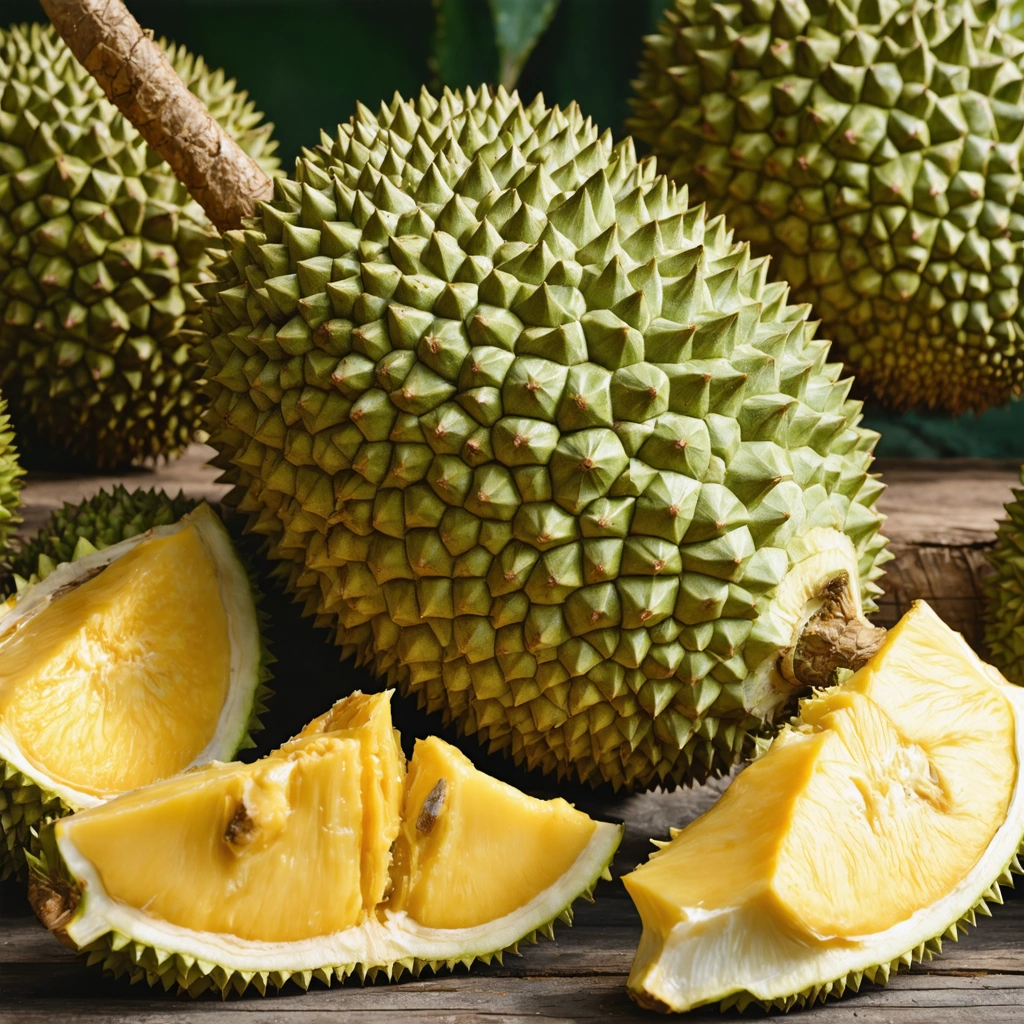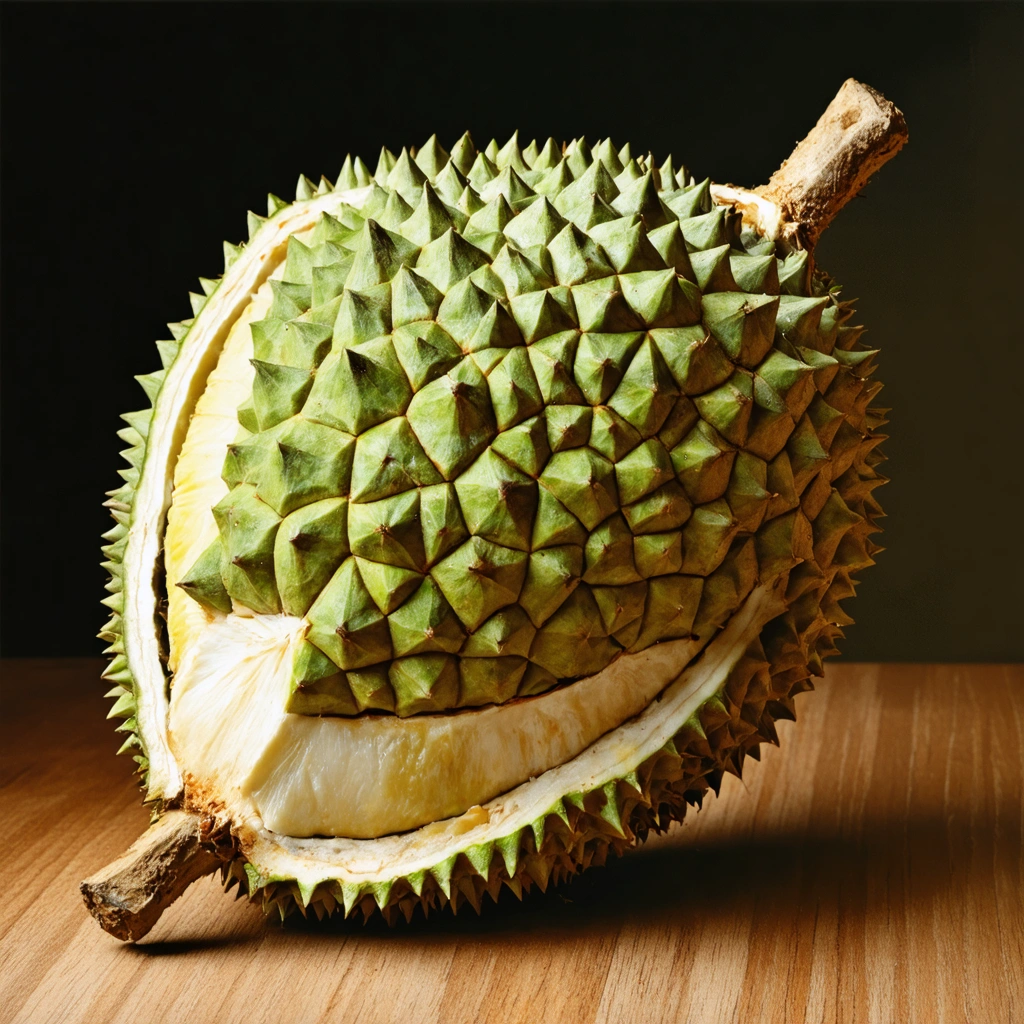
The Bold Aroma That Commands Attention
Imagine walking through a bustling Southeast Asian market, vibrant with color, the air heavy with the scent of mangoes, pineapples, and other tropical fruits. Then, suddenly, your nose is hit by something entirely different—something pungent, almost confrontational. That’s durian fruit making its presence known. If you’ve ever encountered durian, you know it’s not just another fruit; it’s an experience that divides opinions as fiercely as any political debate.
Durian is often dubbed the “King of Fruits” across Asia, celebrated for its rich, custard-like texture and complex flavor. Yet, it’s just as infamous for its powerful aroma, which some describe as sweet and creamy, while others liken it to rotten onions or raw sewage. This stark contrast in perception turns durian into an enigma—beloved by many, avoided by others. The question arises: why does this tropical fruit evoke such polarized reactions, and what does it reveal about our taste buds and cultural boundaries?
Why Does Durian Stir Such Strong Emotions?
To understand the durian phenomenon, we need to unpack the layers of its bold personality. First, there’s the smell—a volatile cocktail of sulfur compounds that triggers the brain’s olfactory receptors in a unique way. This isn’t just a subtle scent; it’s a sensory bombshell. In fact, durian’s aroma is so potent that many hotels and public transportation systems in countries like Singapore and Malaysia ban it outright. But beyond the smell, the flavor itself is an intricate tapestry of sweet, savory, and creamy notes, often described as a blend of almonds, caramel, and garlic.
But here’s the twist: the very qualities that make durian irresistible to some are precisely what put others off. For people unaccustomed to durian or tropical fruits in general, the fruit’s intensity can be overwhelming. Cultural exposure plays a massive role in shaping our palate. In Asia, where durian is woven into culinary traditions—from ice creams and candies to savory dishes—it’s revered. Outside this context, however, durian can be an acquired taste or even a source of bewilderment.
Global Cuisines Meet Durian: Clash or Harmony?
As international travel and global food trends expand, durian is stepping onto the global stage, challenging chefs and foodies alike to embrace its distinct personality. In Western countries, durian is still a niche curiosity, appearing mostly in specialty markets or adventurous restaurants. The clash between durian’s exotic appeal and its sensory boldness sparks fascinating debates about authenticity, adaptation, and acceptance in global cuisines.
For some, durian represents the adventurous spirit of tropical fruits—a chance to explore flavors that defy expectations and push culinary boundaries. For others, it’s a fruit best admired from afar, a reminder that not all tastes translate universally. This dichotomy raises deeper questions about how we define “delicious” and how cultural context shapes our food preferences.
What This Article Will Explore
In the sections ahead, we’ll journey into the world of durian fruit to uncover what makes it so distinctive and why it commands such loyalty and aversion in equal measure. We’ll explore:
- The unique characteristics of durian—its appearance, aroma, and flavor profile
- The cultural significance of durian in various Asian countries and how it shapes local cuisines
- How durian fits into the broader category of tropical fruits and what sets it apart
- The challenges and triumphs of incorporating durian into global culinary scenes
- Practical tips for those curious about trying durian for the first time
Whether you’re a seasoned durian enthusiast or a hesitant skeptic, this exploration promises to peel back the layers of Asia’s most provocative fruit and invite you to reconsider what it means to savor—and sometimes survive—the bold flavors of tropical fruits.

Durian: Asia’s Polarizing Fruit and Its Bold Flavor Impact on Global Cuisines
What is Durian and Why is it Called the “King of Tropical Fruits”?
Durian is a distinctive tropical fruit native to Southeast Asia, renowned for its large size, thorn-covered husk, and most notably, its strong and unique aroma. Often dubbed the “King of Tropical Fruits,” durian commands a special place in the culinary and cultural landscape of countries like Thailand, Malaysia, Indonesia, and the Philippines.
The durian fruit’s bold flavor profile is a complex mixture of sweet, savory, creamy, and pungent notes, making it one of the most polarizing fruits worldwide. While some enthusiasts savor its custard-like texture and rich taste, others find its odor—often described as a combination of rotten onions, sulfur, and sweet almonds—off-putting.
Why Does Durian Fruit Have Such a Strong Smell?
The distinctive smell of durian is due to a complex combination of volatile sulfur compounds. Scientific analysis has identified over 50 different aromatic compounds contributing to its signature odor, including ethanethiol and various esters. These compounds interact to create a smell that humans perceive very differently — a fascinating example of how biochemistry influences food perception.
This potent aroma is so strong that durian is banned in many hotels and public transportation systems across Asia. Yet, this very characteristic also contributes to its allure and exclusivity, making it a sought-after delicacy among tropical fruits.
How Does Durian’s Bold Flavor Divide Palates Globally?
Durian’s flavor divides palates largely due to cultural exposure and individual taste preferences. In Southeast Asia, durian is deeply embedded in food culture, enjoyed fresh or incorporated into desserts, ice creams, and savory dishes. Meanwhile, many Western consumers encounter durian for the first time with little cultural context, often finding its taste and smell overwhelming.
Several factors contribute to this divide:
- Cultural Familiarity: Regular exposure leads to appreciation, while unfamiliarity can trigger aversion.
- Genetic Differences: Variations in olfactory receptors influence how intensely people perceive durian’s smell.
- Preparation Methods: Ripeness, cooking, and pairing with other ingredients can soften or highlight certain flavor notes.
Interestingly, some global chefs and food innovators are experimenting with durian in fusion cuisine, seeking to introduce this tropical fruit in ways that bridge the flavor gap.
What Are the Nutritional and Health Benefits of Durian Fruit?
Beyond its unique flavor, durian is a powerhouse of nutrition. It is rich in vitamins C and B complex, potassium, dietary fiber, and energy-dense carbohydrates. Studies have highlighted several health benefits associated with durian consumption:
- Antioxidant Properties: High levels of vitamin C and phytonutrients help fight oxidative stress.
- Energy Boost: The natural sugars and carbohydrates provide a quick source of energy.
- Digestive Health: Dietary fiber aids in digestion and promotes gut health.
- Heart Health: Potassium helps regulate blood pressure and supports cardiovascular function.
However, given its high-calorie content, durian should be enjoyed in moderation as part of a balanced diet.
How is Durian Grown and Harvested Among Tropical Fruits?
Durian trees thrive in humid tropical climates with well-drained soil, commonly found in Southeast Asia’s equatorial belt. The cultivation process is labor-intensive and requires patience, as durian trees can take 4 to 8 years to yield fruit. Here’s an overview of the growth and harvesting cycle:
- Planting: Durian trees are typically propagated from seeds or grafted seedlings for better fruit quality.
- Growth Period: Trees mature over several years, requiring adequate rainfall and temperature around 24-30°C (75-86°F).
- Flowering and Pollination: Durian flowers bloom at night and rely on bats, insects, and wind for pollination.
- Fruit Development: Once pollinated, fruits take 3 to 5 months to mature.
- Harvesting: Fruits are harvested when mature but before natural drop, to avoid damage. Some farmers let durians fall naturally and collect them carefully.
Due to these factors, durian is considered a premium tropical fruit, often commanding high market prices.
What Are Common Culinary Uses of Durian Across Asia and Beyond?
Durian’s versatility has allowed it to feature in a wide range of culinary applications, often reflecting local tastes and traditions. Some popular uses include:
- Fresh Consumption: The simplest way to enjoy durian is fresh, eaten straight from the husk.
- Desserts: Durian ice cream, cakes, pastries, sticky rice with durian, and custards are beloved treats.
- Snacks: Durian chips and candies have gained popularity as portable snacks.
- Savory Dishes: In some regions, durian is incorporated into curries and sauces, showcasing its umami potential.
As durian’s global profile grows, chefs worldwide are experimenting with this tropical fruit in innovative ways, blending tradition with modern gastronomy.
How Can One Acclimate to Durian’s Flavor if Trying it for the First Time?
For newcomers wary of durian’s strong aroma and taste, gradual exposure and strategic preparation can help build appreciation:
- Start with durian-flavored products like ice cream or candies which have milder flavors.
- Try durian mixed with other ingredients, such as in desserts combining coconut or mango, to balance its intensity.
- Consume durian in well-ventilated areas to minimize the impact of its smell.
- Learn from locals or experts to understand the best ripeness stage and serving methods.
This approach allows the palate to adjust and often reveals the complexity and richness that durian lovers cherish.
What Role Does Durian Play in Asian Culture and Economy?
Durian is more than just a fruit; it is deeply intertwined with cultural identity and economic livelihoods in many Asian countries. Festivals celebrating durian harvests attract tourists, while the fruit’s export provides valuable income to farmers and exporters.
For example, Thailand is one of the largest exporters of durian fruit globally, with exports reaching over 400,000 tons annually as of recent years. The growing international demand, especially from China, has driven innovation in durian farming and supply chain management.
Culturally, durian features prominently in folklore, traditional medicine, and social gatherings, symbolizing abundance and uniqueness.



